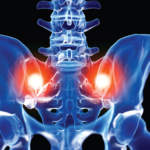However, any conclusions on the efficacy of these antibodies in the alternative axPsA phenotype must be regarded with caution, for the following reasons. First, the studies were not primarily designed to look at the efficacy of these drugs in axPsA. Second, as noted above, in the absence of a validated definition of axPsA, it is difficult to know exactly what sort of patients were included as axPsA, although patients in the IL-23 studies were required to have radiographic sacroiliitis.
Third, and most importantly, the outcome measure used to define efficacy, the Bath Ankylosing Spondylitis Disease Activity Index (BASDAI), although standard for trials in axSpA, is not appropriate on its own for studies in patients who have a significant amount of peripheral arthritis, as was the case in these studies. Even selecting out the specific spine-focused questions of the BASDAI and examining response using only these items may be unreliable in patients with concomitant peripheral disease.16
Developing a New Definition of axPsA
Recognizing the clinical, radiographic and genetic differences of the psoriatic phenotype has prompted a joint effort by ASAS and the Group for Research and Assessment of Psoriasis and Psoriatic Arthritis (GRAPPA) to develop a new definition of axPsA, the AXIS trial (NCT04434885).17 This multinational, multicenter, cross-sectional study of 400 patients with PsA presenting with peripheral involvement will collect clinical, imaging and laboratory findings, with the aim of developing universally accepted classification criteria for axPsA.
This collaborative effort has already received expert consensus; in an online discrete choice experiment, physicians overwhelmingly opted for mandatory positive axial imaging as a classification criterion for axPsA.18 Hopefully this will satisfy the urgent need for an evidence-based and widely accepted definition of axial involvement in PsA that will allow us to define a homogeneous group of patients in which appropriate epidemiologic, clinical and interventional studies can be performed.
Similarly, the ongoing phase 4 STAR study (NCT04929210) will compare the efficacy of guselkumab, an IL-23 inhibitor, with placebo, in patients with peripheral arthritis who meet the Classification Criteria for Psoriatic Arthritis (CASPAR) and have inflammation of the spine and/or sacroiliac joint detected by centrally read magnetic resonance imaging. This study will help define axPsA and examine the efficacy of this drug in both the classic and alternative phenotypes of axial disease, thus helping resolve the uncertainties identified above.
 Philip Helliwell, DM, PhD, FRCP, is the professor of clinical rheumatology, Leeds Institute of Rheumatic and Musculoskeletal Medicine, University of Leeds, England.
Philip Helliwell, DM, PhD, FRCP, is the professor of clinical rheumatology, Leeds Institute of Rheumatic and Musculoskeletal Medicine, University of Leeds, England.



